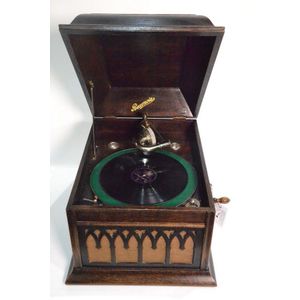Rexnola Oak Gramophone with Handle
Rexnola Gramophone table top Gramophone. rd no. 3901. In oak case, with handle. 15.75 in. x 20.08 in.
You must be a subscriber, and be logged in to view price and dealer details.
Register Now to view actual auction price for this item.
- Registered Numbers - Between 1842 and 1883, a diamond- shaped mark was used to identify items as British-made, which classified the item according to the material from which it was manufactured, as well as the date of registration. This system was discontinued in 1884 when a numbering system was introduced.
Design registration is for "what and item looks like", and is not a patent ("how something works") or trade mark ("what it is called").
The registered number is usually on an under-surface of an object (on the base of ceramics) and oftern shown as "Rd. No. 99999", sometimes surrounded by a rectangular box.
The table below lists the year, and the first registered number for that year:
1884 1
1885 18,993
1886 39,547
1887 61,207
1888 87,266
1889 111,664
1890 140,481
1891 160,613
1892 183,259
1893 203,348
1894 223,861
1895 244,726
1896 266,237
1897 288,848
1898 309,956
1899 328,527
1900 349,120
1901 367,628
1902 380,979
1903 401,944
1904 422,489
1905 428,004
1906 469,160
1907 486,464
1908 516,375
1909 533,561
1910 546,084
1911 561,570
1912 585,707
1913 608,541
1914 627,887
1915 642,613
1916 651,079
1917 655,001
1918 662,576
1919 665,728
1920 664,869
1921 676,491
1922 685,412
1923 691,571
1924 695,944
1925 705,943
1926 716,386
1927 723,430
1928 725,899
1929 740,459
1930 741,336
1931 757,945
1932 767,110 - Oak - Native to Europe and England, oak has been used for joinery, furniture and building since the beginning of the medieval civilisation. It is a pale yellow in colour when freshly cut and darkens with age to a mid brown colour.
Oak as a furniture timber was superceded by walnut in the 17th century, and in the 18th century by mahogany,
Semi-fossilised bog oak is black in colour, and is found in peat bogs where the trees have fallen and been preserved from decay by the bog. It is used for jewellery and small carved trinkets.
Pollard oak is taken from an oak that has been regularly pollarded, that is the upper branches have been removed at the top of the trunk, result that new branches would appear, and over time the top would become ball-like. . When harvested and sawn, the timber displays a continuous surface of knotty circles. The timber was scarce and expensive and was used in more expensive pieces of furniture in the Regency and Victorian periods.
This item has been included into following indexes:
